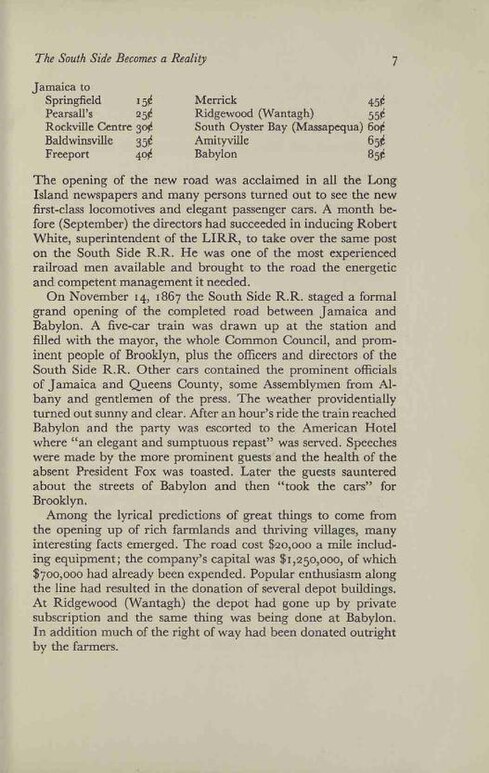Jamaica to
| Springfield | 15¢ | Merrick | 45¢ | |
| Pearsall's | 25¢ | Ridgewood (Wantagh) | 55¢ | |
| Rockville Centre | 30¢ | South Oyster Bay (Massapequa) | 60¢ | |
| Baldwinsville | 35¢ | Amityville | 65¢ | |
| Freeport | 40¢ | Babylon | 85¢ |
The opening of the new road was acclaimed in all the Long Island newspapers and many persons turned out to see the new first-class locomotives and elegant passenger cars. A month before (September) the directors had succeeded in inducing Robert White, superintendent of the LIRR, to take over the same post on the South Side R.R. He was one of the most experienced railroad men available and brought to the road the energetic and competent management it needed.
On November 14, 1867 the South Side R.R. staged a formal grand opening of the completed road between Jamaica and Babylon. A five-car train was drawn up at the station and filled with the mayor, the whole Common Council, and prominent people of Brooklyn, plus the officers and directors of the South Side R.R. Other cars contained the prominent officials of Jamaica and Queens County, some Assemblymen from Albany and gentlemen of the press. The weather providentially turned out sunny and clear. After an hour's ride the train reached Babylon and the party was escorted to the American Hotel where "an elegant and sumptuous repast" was served. Speeches were made by the more prominent guests and the health of the absent President Fox was toasted. Later the guests sauntered about the streets of Babylon and then "took the cars" for Brooklyn.
Among the lyrical predictions of great things to come from the opening up of rich farmlands and thriving villages, many interesting facts emerged. The road cost $20,000 a mile including equipment; the company's capital was $1,250,000, of which $700,000 had already been expended. Popular enthusiasm along the line had resulted in the donation of several depot buildings. At Ridgewood (Wantagh) the depot had gone up by private subscription and the same thing was being done at Babylon. In addition much of the right of way had been donated outright by the farmers.
